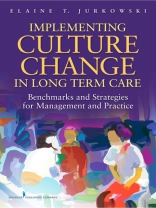‘As one who is involved in the culture change movement and is trying to review the huge volume of available resources, I find it refreshing to have a book that draws it all together….I highly recommend this book to administrators who are overwhelmed at the thought of implementing change in their environment. The author has done an excellent job of making it seem quite possible to make culture change a reality.’– Doody’s Medical Reviews
‘The publication of Implementing Culture Change in Long-Term Care marks the beginning of a new era in the aging services profession. This book is the Rosetta Stone of the culture change movement. Dr. Jurkowskiís skillful blend of theory, research, and practice addresses the movementís most urgent needs and makes the work of culture change advocates accessible to a broader and more influential audience….This book is the future in paper and ink.’
From the Foreword by Bill Thomas , MD
Founder of the Eden Alternative and the Green House Project
This text offers a strategic approach for promoting an active culture of change in long-term care facilities for older adults and people with disabilities. It discusses the philosophical framework for the delivery of care in these settings and addresses the changing landscape of our long-term care population. With the aim of transforming these facilities from institutional settings to person-centered, homelike environments, the book offers administrators and practitioners numerous strategies and benchmarks for culture change, and addresses tools and resources to support the culture change process. The text describes how these benchmarks have been met and provides ways to address not just knowledge, but also attitudes and behavior, important components of a culture change strategy.
The book compares and contrasts current long-term care paradigmsóthe medical model, the rehabilitation paradigm, the independence and dignity model, and strength-based approachesóin order to see how they facilitate or impede culture change. It provides best practice examples of benchmarks to be attained along with strategies to promote this process. These benchmarks and strategies are based upon the Artifacts for Culture Change Assessment Tool developed by the Centers for Medicare and Medicaid. The text describes ways to build a blueprint and strategic processes for integrating these benchmarks into a long-term care setting, addressing the entire process from assessment through evaluation. It also provides tools enabling readers to learn from their own process via a feedback loop, and includes strategies to facilitate partnerships with family, staff, and community.
Key Features:
- Elucidates benchmarks that can be implemented in long-term care settings, using the Centers for Medicare/Medicaid’s ‘Long Term Care Artifacts’ assessment tool as an intervention
- Focuses on care practices, the environment, the inclusion and integration of family and community, leadership benchmarks, and workplace practices
- Includes robust examples of best practices within each of the main artifact arenas
- Incorporates tools and strategies for assessing the philosophical paradigm of a long- term facility that can help or hinder the culture change process
- Provides discussion and reflection questions and websites for additional resources
Daftar Isi
Foreword
Preface
PART I ñ ESTABLISHING A CONTEXT FOR SHAPING LONG TERM CARE SETTINGS.
Chapter 1 The changing landscape of our long term care population
Chapter 2 Introduction to Long Term Care Settings and Culture change.
Chapter 3 Philosophical paradigms impacting long term care settings.
Chapter 4 Artifacts of culture change ñ Overview of purpose and measurement practices.
PART II ñ STRATEGIES AND BENCHMARKS FOR CULTURE CHANGE
Chapter 5 Care Practices
Chapter 6 Environment benchmarks/artifacts
Chapter 7 Family and community benchmarks/artifacts
Chapter 8 Leadership benchmarks/artifacts
Chapter 9 Workplace practice benchmarks/artifacts
Chapter 10 Outcomes
PART III ñ TOOLS AND RESOURCES TO FACILITATE THE CHANGE PROCESS
Chapter 11 The assessment process: Identifying a road map for success.
Chapter 12 From Assessment to Action: Building on the planning process
Chapter 13 Partners for change: Residents and Family
Chapter 14 Building coalitions of effective change agent teams
Chapter 15 Legal and regulatory bodies and the culture change process
Chapter 16 A vision for the future
Tentang Penulis
Elaine Theresa Jurkowski, Ph D, MSW, is a professor at Southern Illinois University Carbondale’s School of Social Work, where she teaches courses in health and aging policy, research, and program evaluation and social work practice. Dr. Jurkowski also holds joint appointments with the Department of Public Health and Recreation Professions and SIU’s School of Medicine’s Family Practice Residency Program.












